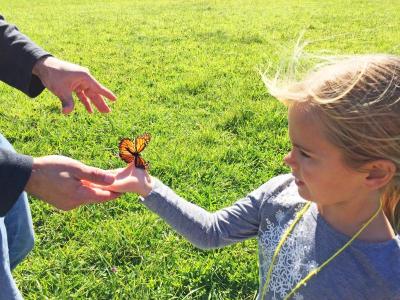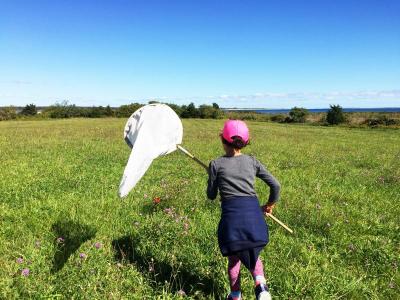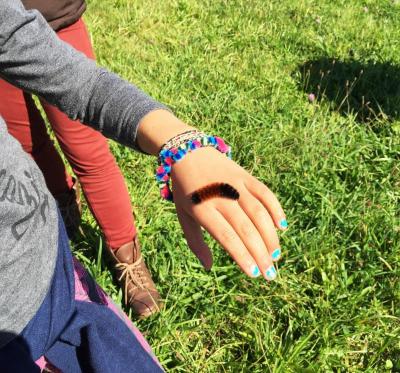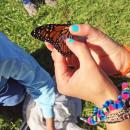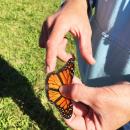Research takes flight at monarch tagging event
A handful of dedicated volunteers spent a sunny Saturday capturing and tagging monarch butterflies at Allens Pond Wildlife Sanctuary in a nationwide project to learn more about the creatures’ migration patterns.
Under the watchful eye of sanctuary Property Manager Lauren Miller-Donnelly, people of all ages from as far afield as Easton spent hours chasing down the bright orange and black butterflies in the early autumn sun.
It was the second tagging day of the season. “We did one last Saturday, which was a phenomenal day,” she said. “We tagged 150 monarchs last weekend.”
Tagging the butterflies involves holding their wings together — carefully — and placing a round sticker in a particular spot near the scent glands in the middle of the outer right wing.
Miller-Donnelly said that the butterflies would still be able to fly with the stickers.
“They put monarch butterflies through wind tunnels to figure out how they would handle different locations [for the stickers],” she said. “And they determined that towards the center of the body... is kind of their center of mass, and has the least impact on their flight.”
For each butterfly caught, Miller-Donnelly noted on a clipboard the butterfly’s sex, whether its wings were damaged, the date and location, and whether the caterpillar was reared or wild.
This data is entered in an online database so that if researchers capture the same butterfly, they will read the number on the stickers and know where that butterfly was last caught.
Monarchs travel from all over North America to get to their wintering grounds in Mexico.
Although the species itself is not listed as endangered, their numbers are dropping in the U.S. due in part to habitat loss, widespread use of pesticides and herbicides — which kill the caterpillars’ favorite food, the milkweed plant — as well as climate change bringing more severe weather each year.
These butterflies at Allens Pond may have been born in the meadows around the field station, or they may be stopping to rest on their way south from Canada or Maine.
Either way, they were all gearing up for the long trip south. Miller-Donnelly said that many could be found again in New Jersey, Texas, and Mexico.
But parts of their migration remain a mystery — especially how they can travel so far, and how three or four generations later, the butterflies know where to return.
“These guys just hatched not long ago, and they’re going to Mexico. They’ve never done that migration before,” said Westport resident Rachel Medeiros, who brought her seven-year-old along for the fun. “It’s just like encoded in them to do that...It’s amazing.”
On Saturday, members of the public caught around 12 monarchs per hour, which Miller-Donnelly said is a good number for the first week of October.
“The last week of September has typically been the peak,” she said, adding that last weekend they caught so many she had to set aside stickers to save for this event.
“I love it,” said Fairhaven resident Judy Lavoie. “I can’t wait to bring my grandson when he’s old enough. I would just be chasing him instead of the butterflies with the net!”
“This is my third one,” bragged six-year-old Samara Korejwa, showing off a bunched-up net with a wildly fluttering monarch inside.
“She caught three, two of which were monarchs,” said dad Adam with a smile. “Let’s be accurate.”
As she carefully held the newly tagged butterfly, ready to let it go, she giggled. “It tickled my thumb!”
Monarchs tagged at Allens Pond will be tracked on the website monarchwatch.org if recaptured.





